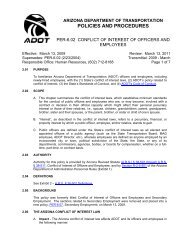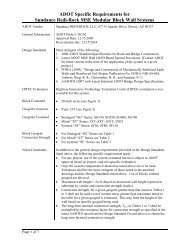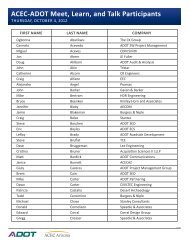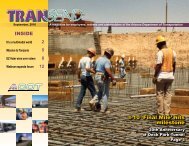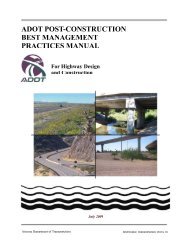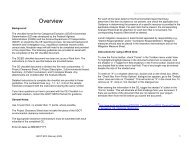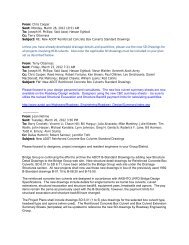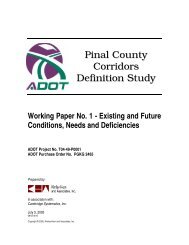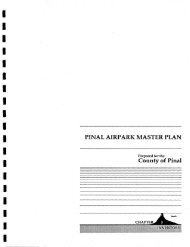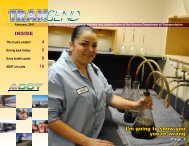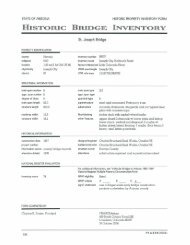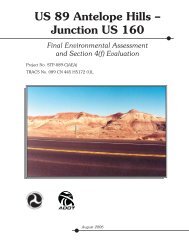I-10 Twin Peaks Traffic Interchange, Environmental Assessment
I-10 Twin Peaks Traffic Interchange, Environmental Assessment
I-10 Twin Peaks Traffic Interchange, Environmental Assessment
You also want an ePaper? Increase the reach of your titles
YUMPU automatically turns print PDFs into web optimized ePapers that Google loves.
Affected Environment and <strong>Environmental</strong> Impacts October 2005<br />
Mitigation<br />
No mitigation measures are required because the preferred alternative would have<br />
no effects on agricultural land.<br />
Conclusion<br />
The preferred action would not alter or impact slopes or substantially effect<br />
important topographic features in the project area. Although disturbed soils in the<br />
project area would be vulnerable to water and wind erosion, the SWPPP and air<br />
quality permitting regulations followed for this project would result in no impacts<br />
to area soils. The preferred alternative would have no effects on the geological<br />
setting or mineral resources in the project area and no prime, unique, or farmland<br />
of state or local importance exists within the project area; therefore, the preferred<br />
alternative would have no effects on agricultural land.<br />
Water Resources<br />
The following sections discuss surface water and groundwater conditions within<br />
the study area. Surface water resource concerns include potential impacts to rivers<br />
and intermittent washes. The Santa Cruz River and numerous washes that drain<br />
into the Santa Cruz River are the dominant surface water features in the study area.<br />
Groundwater is defined as stored water beneath the ground surface that can be<br />
used to supply wells and springs. This water is stored in natural underground<br />
reservoirs composed of loose rock fragments called aquifers.<br />
Surface Water<br />
Existing Conditions<br />
The main surface water drainage in the study area is the Santa Cruz River, which<br />
runs approximately parallel to and west of I-<strong>10</strong> within the study area. The Santa<br />
Cruz River originates in the San Rafael Valley in Arizona, and then flows south<br />
into Mexico before bending west and north and reentering the United States east of<br />
Nogales, Arizona. Near the study area, a perennial nine-mile reach of the Santa<br />
Cruz River flows north consisting of treated effluent discharged into the channel<br />
by the Ina Road and Roger Road Wastewater Treatment Plants. According to the<br />
Arizona Department of <strong>Environmental</strong> Quality (ADEQ), the portion of the Santa<br />
Cruz River that flows through the study area is classified as Effluent Dominated<br />
Waters. Swimming and fishing are deemed not allowable uses for the Santa Cruz<br />
River, but it is suitable for bird-watching and other terrestrial activities. With the<br />
exception of this effluent dominated reach, the remainder of the Santa Cruz River<br />
within the study area is intermittent and flows in response to rainfall events.<br />
The Canada del Oro Wash and many minor unnamed washes drain into the Santa<br />
Cruz River within the study area. All of these washes are ephemeral, flowing only<br />
in response to rainfall events. According to the Drainage Report prepared for this<br />
study, the Canada del Oro Wash and several minor unnamed washes originate in<br />
Interstate <strong>10</strong> <strong>Traffic</strong> <strong>Interchange</strong> at<br />
<strong>Twin</strong> <strong>Peaks</strong>/Linda Vista<br />
4-9<br />
Project No.: NH-0<strong>10</strong>-D (AIW)<br />
TRACS No.: <strong>10</strong> PM 236 H5838 01D



